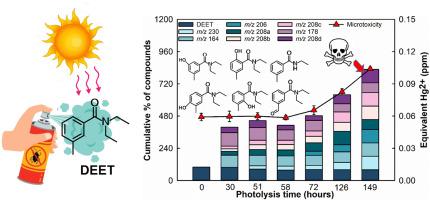Unveiling the potential health risks induced by photolysis of insect repellents DEET under simulated sunlight
IF 8.7
Q1 Environmental Science
引用次数: 0
Abstract
N, N-diethyl-m-toluamide (DEET) is a widely used active ingredient in insect repellents, particularly in areas where mosquitoes are prevalent. Although the photolysis of DEET is inevitably to occur when exposed to sunlight, the potential risks associated with its transformation products have not been extensively studied. In this study, multiple in-vitro bioassays were conducted to examine the microtoxicity, genotoxicity and estrogenic effects of these products. Subsequently, ultraperformance liquid chromatography coupled with triple time-of-flight mass spectrometry (UPLC-TripleTOF) was adopted to identify the molecular structures of the main photolysis products. Ultimately, the correlation between the products and their toxicities was analyzed to spot the compounds potentially responsible for the elevated toxicity. The results showed that although DEET was only moderately degraded under sunlight, with a 20% reduction after photolysis, the microtoxicity was increased by 83.3%, indicating the formation of toxic products. The characterization results revealed that eight main photolysis products were generated via de-alkylation, oxidation, and electrophilic substitution. Among these, six products containing the N-ethyl-m-toluamide functional group were found to be microtoxic. Fortunately, no genotoxic or estrogenic products were produced during DEET photolysis with simulated sunlight. These noteworthy findings emphasized the potential risks associated with the use of DEET-containing topical insect repellents when exposed to sunlight.

揭示驱蚊剂避蚊胺在模拟阳光下光解对健康的潜在危害
N, N-二乙基-m-甲苯酰胺(DEET)是一种广泛用于驱蚊剂的有效成分,特别是在蚊子普遍存在的地区。虽然避蚊胺在阳光照射下不可避免地会发生光解作用,但其转化产物的潜在风险尚未得到广泛研究。在这项研究中,进行了多次体外生物测定,以检查这些产品的微毒性,遗传毒性和雌激素效应。随后,采用超高效液相色谱-三重飞行时间质谱法(UPLC-TripleTOF)对主要光解产物的分子结构进行鉴定。最终,分析了产品与其毒性之间的相关性,以发现可能导致毒性升高的化合物。结果表明,虽然避蚊胺在日光下仅被中度降解,光解后还原20%,但微毒性增加83.3%,表明有毒产物的形成。表征结果表明,通过去烷基化、氧化和亲电取代等途径产生了8种主要的光解产物。其中,含有n -乙基-间甲酰胺官能团的6种产品被发现具有微毒性。幸运的是,避蚊胺在模拟阳光下光解过程中没有产生遗传毒性或雌激素产物。这些值得注意的发现强调了使用含有避蚊胺的局部驱蚊剂暴露在阳光下时的潜在风险。
本文章由计算机程序翻译,如有差异,请以英文原文为准。
求助全文
约1分钟内获得全文
求助全文
来源期刊

Water Cycle
Engineering-Engineering (miscellaneous)
CiteScore
9.20
自引率
0.00%
发文量
20
审稿时长
45 days
 求助内容:
求助内容: 应助结果提醒方式:
应助结果提醒方式:


